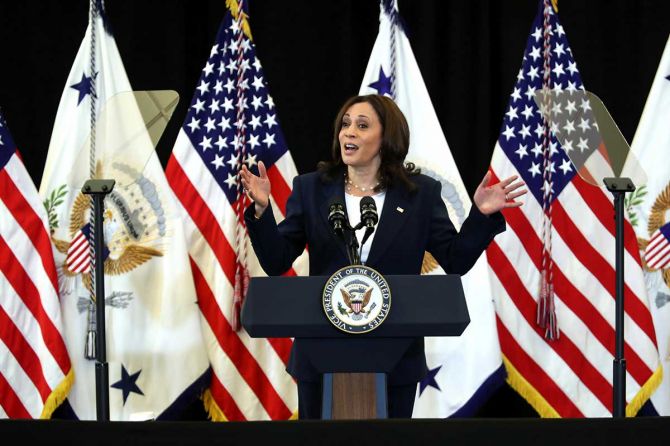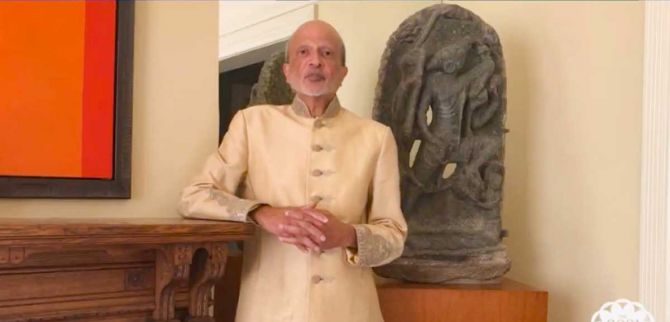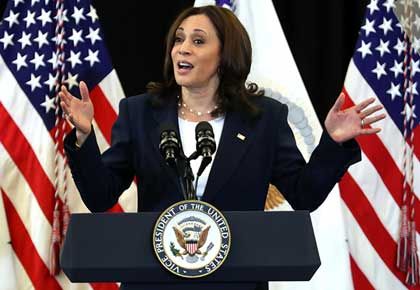 | « Back to article | Print this article |
Kamala succeeded as she identified herself with the larger minority groups rather than narrow ethnicity, prodded by her mother who did not want to return to India, observes Ambassador T P Sreenivasan, who has done multiple stints in India's embassy in Washington, DC.

A new book, edited by the veteran journalist Tarun Basu, with three decades of association with tracking the Indian American community through his various media responsibilities, has just been published by Wisdom Tree entitled Kamala Harris and the Rise of Indian Americans.
The twenty essays authored by Indian and Indian American authors contained in the book are a treasure of information, which places Kamala Harris's election as the vice-president of the United States in the context of the rise of the Indian community and clears the cobwebs shrouding her beliefs and prospects.
The election of Kamala Devi Harris, the first woman vice-president of the United States and that too of Indian-Jamaican origin with strong cultural links with India, should have been an occasion for unbridled celebration among the Indian Americans and Indians themselves.
This was a long-awaited moment, a culmination of a long journey of Indian migrants who arrived in the Promised Land with little cash in the pocket, but a surfeit of dreams in the heart. It was a long saga of extraordinary accomplishments, not without trials and tribulations.
The ambitions of the migrants kept growing and finally went beyond medical degrees and hotel cartels and millionaire companies to political ambitions.
The trajectory was clear and the success of several Indian Americans was notable. But to reach the top, leaders need more than personal achievements, wealth or a certain cultural identity.
They have to acquire an essentially American character, which is a blend either of white or black identity with some ethnicity.
Kamala succeeded as she identified herself with the larger minority groups rather than narrow ethnicity, prodded by her mother who did not want to return to India. She could not be identified as an Indian, but only as a black American and that is how she succeeded.
For this reason, in the eyes of Indians and many Indian Americans, Kamala Harris did not appear to be an ideal choice for the Indian Americans and India.
Her primary identification with the black American community, her views about some important Indian issues, based on her understanding of human rights around the world and her standards of behaviour of democracies became controversial.
At the same time, the community extended considerable support to her during the elections. Some Indians, who had shifted to the Republican party, returned to the Democratic party after she was nominated and sizeable funds were raised by various Indian groups.
The book is extremely important against this backdrop to remove any misgivings about her and to reassure the community that she will have the interests of India also in mind as she proceeds.
Several contributors have dealt with the identity issue.
Tarun Basu explains: 'She is called biracial because of her estranged Jamaican father, and she rarely talked publicly about her Indian heritage till her vice-presidential nomination, as being a politician, she presumably preferred a broader "South Asian" or "African" identity label to appeal to a larger panoply of voters.'
'My mother, grandparents, aunts and uncle instilled us with pride in our South Asian roots ... we were raised with a strong awareness of and appreciation of Indian culture,' she writes in her memoir.
Aziz Haniffa, the redoubtable chronicler of Indian Americans for many years, asserts that "the influence of her mother was all encompassing".
Shashi Tharoor quotes E C G Sudarshan as having said, 'If you look at the world with two eyes, you see more. It is possible to live in two worlds.'
There are several essays, tracing Indian American aspirations for political power, which had humble beginnings, because they did not have a broader view of the world. They focused on communal activities which remained within the communities.
Only in the last few years, several Indians stepped into the larger political arena. But once they realized that political power was attainable, they swiftly moved in.
Each case of success at different levels has been fully documented in the book.

M R Rangaswami has traced the rise of Silicon Valley, which began as a home of a few programmers and became a hub of technological activity fueled by young Indians. His narrative is gripping because of the speed with which workers became entrepreneurs and then became CEOs.
Silicon Valley became instrumental in driving economic growth in the twenty-first century and thus enhanced the value of every Indian, including those of mixed descent.
Kamala Harris herself must have been the inheritor of the Indian legacy in her own rise.
Indian names became household words and CEOs sported their seemingly tongue twister names. Nobody wanted to change their names from Krishnan to Kris or Subramanian to Subu! Gourmet Indian food flourished everywhere.

Pradeep Khosla and Suman Guha tell the saga of an equally amazing growth of professors and academic administrators, many of them spectacular achievers.
C K Prahlad, Amar Bose, Dipak Jain and Geetha Gopinath are among the stellar performers in academia.
Amartya Sen and Abhijit Banerjee won Nobel Prizes, but Jagdish Bhagwati became a non-Nobel celebrity.
The Bhagwati Chair at Columbia was set up by the Indian Americans through small and big contributions.
Raj L Gupta writes about Indian Americans fostering a new wave of corporate leadership.
Indian philanthropy is described in detail by Deepa Raj and Ashish Shah.
The Indian physicians and hoteliers were also among the achievers in the Indian community.
People believe that there is a Patel Hotel Cartel, which started off with roadside hotels, but ended up owning Hayatts and Hiltons.
The physicians are still the most influential Indians in the white community.
Many Senators and Congressmen joined the India Caucus on the recommendations of Indian physicians.
Indian women have straddled all groups of Indians, but a separate chapter on 'Success through lens of women' is more than justified.
The elegant epilogue, penned by Ambassador Arun Singh is a fitting finale of the book. His long experience in Washington has given him a unique perspective of the role of the Indian community.
My own chapter on Indian Americans as 'Ambassadors'mof India covers the same ground over my ten years in the US.
The merit of the book is its authenticity and meticulous editing.
Some may observe that this book has very little on Kamala Harris and more about the Indian community. That appears deliberate as there are several books on Kamala Harris, but this is the only one, which comprehensively covers the rise of the Indian Americans in the context of the emergence of Kamala Harris as the daughter of an Indian migrant, just a heartbeat away from the White House.
Ambassador T P Sreenivasan (IFS 1967) is a former Ambassador of India and Governor for India of the IAEA.
A frequent contributor to Rediff.com, you can read his fascinating columns here.
Feature Presentation: Ashish Narsale/Rediff.com
